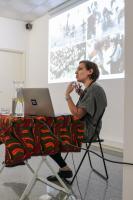mozambican artists
Articles tagged with mozambican artists
Tag Archive
- activism
- África do Sul
- African Americans
- african screens
- Afrique
- Almada Negreiros
- António Pinto Ribeiro
- art as activism
- arte contemporânea
- artists
- Belgium
- Biennial Conference Network Afroeuropeans:
- black art
- black is beautiful movement
- black music
- Boaventura Sousa Santos
- Brasil
- brazilian film
- Cacheu
- capitalism
- César Schofield Cardoso
- Cidade do Cabo
- Claire Andrade-Watkins
- Cuba
- Cuca
- drawing literature
- e a Raquel da Silva. Menciono também de passagem: Homi Bhabha
- economy
- esse cabelo
- Euridice Kala
- eurocentrism
- europa oxalá
- Exhibition
- Falcão Nhaga
- Filipe Mukenga
- genocide
- geological phenomena
- Goli Guerreiro
- humanist paradigm
- imigrantes
- immigrant
- installation
- insurreições
- intelectualidade brasileira
- intellectuals
- iwalewahaus
- journalism
- Julie Dash
- Kepha Oiro
- kim praise
- Leão Lopes
- Lee-Ann Olwage
- lendas
- LGBTI
- Licínio Azevedo
- Londres
- luquebano afonso
- Luso-Tropicalism
- lusofonia
- Maputo Fortress
- Michel Figueiredo
- migratory politics
- mozambican artists
- não dá para ficar parado
- Neocolonialism
- nepal
- New Orleans
- Pipas Forjaz
- plantation
- police brutality
- Portraits
- pos-colonial
- post-colonial
- post-memory
- Práticas artísticas
- Rabbit Hole
- racism
- refugiados
- representação
- return
- Ricardo Farinha
- Sambizanga
- semba
- spaces of invention
- Sudan
- Super Camões Richard Zenith
- tabu
- Tarnac
- Teaching
- Teatro Praga
- theo gould
- Tuchangamke
- visual Arts
- Vital Matter
- vodou
- walk
- welket bungué
- xx
- xxx
- zines
 My research on the nonaligned comes from a cultural and art-historical position. It is an interdisciplinary approach to understanding how the non-aligned movement, apart from creating political, or social, or economic alliances was also attempting to create cultural alliances that would counter Western cultural hegemony, and what many in the movement, who were interested in culture, also called Western cultural imperialism.
My research on the nonaligned comes from a cultural and art-historical position. It is an interdisciplinary approach to understanding how the non-aligned movement, apart from creating political, or social, or economic alliances was also attempting to create cultural alliances that would counter Western cultural hegemony, and what many in the movement, who were interested in culture, also called Western cultural imperialism. 